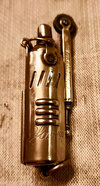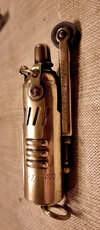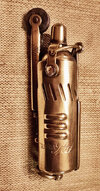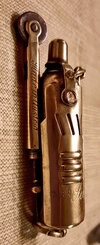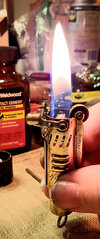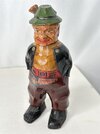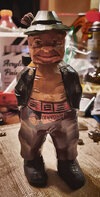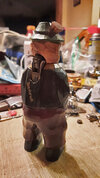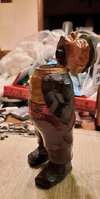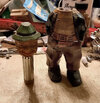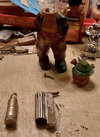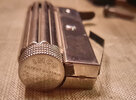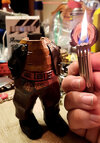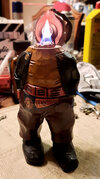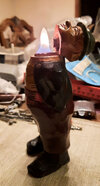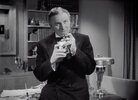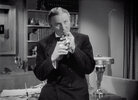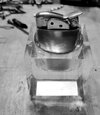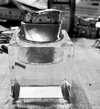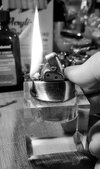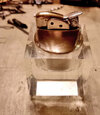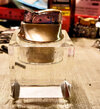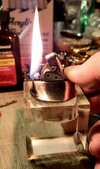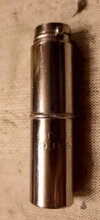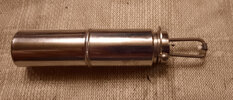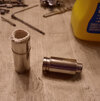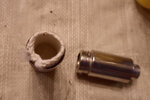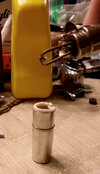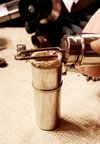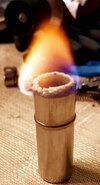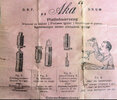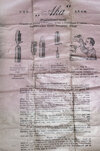IMCO IFA 4100 (1935)
Given this lighter isn't on the IMCO history charts photos and the IMCO 4000 was 1934 and the IMCO 4400 was 1936, I'm assuming this one must be from 1935. The 4000 was a Streamline. This one is round like the original IFA lighter models. It was followed up by the 4400 in 1936 that is Octagonal and has two thumb rest ridges. I've seen one other 4100 in a photo and it had 2 ridges, so that clearly was carried on in the progression to the 4400 (I assume the octagonal shape was to increase strength of the body from getting crushed or something of that nature, but that's only a guess). This one, however has 3 ridges, but otherwise has the same markings as the other 4100 I saw.
So, given the lack of appearance in their own lighter history chart and thus far having only come across two of these on the planet (which in no way means there aren't thousands more sitting somewhere, even if it's a landfill), I have to wonder if it was simply not selling well enough due to a lack of difference between it and the IFA Extra (which it otherwise closely resembles other than the lack of 2 or 3 thumb rests), despite being made 7 years apart (the IFA Extra being much more common, but still uncommon compared to the 1926 IFA, which is the most common version as near as I can tell by available lighters for sale) or if it was a sort of experimental prototype set of changes (explaining why there's at least two versions with 2 or 3 ridges) that then was quickly incorporated into the 4400 a year later.... I simply can only guess until if/when I come across more information.
This one appeared to be in relative good condition on the outside. I took it apart and the inside was much more heavily tarnished, so I'm guessing someone polished the outside jacket at some point (it still cleaned up on the outer jacket considerably more when I polished both of them), but didn't take it apart to polish the inside lighter at the time.
The really strange thing is the outer jacket is in more or less excellent condition, but the inner lighter body has several dings/dents in it, some kind of deep, really which is more than just a pocket squeeze kind of damage, but that then begs the question of why the outer jacket wasn't also damaged in whatever accident the lighter was involved in and I simply don't have an answer. I can speculate that the outer jacket doesn't actually go with this lighter body or something happened at some point when it was taken apart. The thing is that the inner body is identical to the very common 1926 IFA lighter in every respect (same patent number, Made In Austria and IMCO logos, etc.) and only the outer jacket is different with the IFA Extra slanted vents, 4100 designation and extra thumb rests.
So, I could actually take a perfect 1926 body and apply the jacket to it and have a perfect 4100 for all intents and purposes as there is no way to tell them apart underneath. On the other hand, with the jacket on, you can't really see any of the dents with it shut and only a small bit when it's in the open position to light and, of course, it doesn't affect the lighter operation one bit. I also have no idea what its actual true value is since I have no pricing information and only eBay and other sales sites to gauge values for most of their lighters (only a few appear in one of my books). I got it for less than some 1926 lighters often ask, despite its rarity (I guess the people that might be most interested, if any, already have one and/or weren't looking for it).
In any case, with a new wick and packing installed and loosening the flint spring mechanism (unscrew slightly) so I could actually pull it back far enough to put a flint in (It was way too tight to fit a brand new flint in it the way it was) along with a good Flitz™ polish, it's working great (lights every time) and looks good. And if anyone has read this far, congratulations for being interested in IMCO lighter history, such as it is.
Click to view larger pictures/slideshow:
View attachment 1743104 View attachment 1743103 View attachment 1743102 View attachment 1743101 View attachment 1743100

